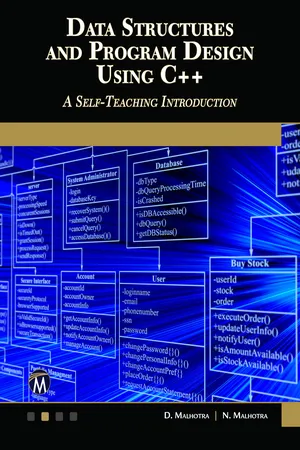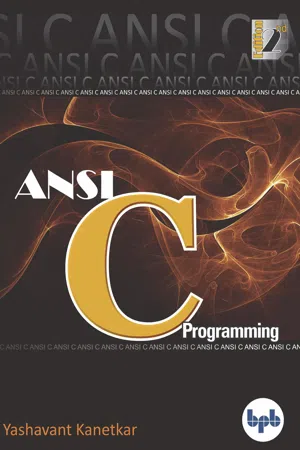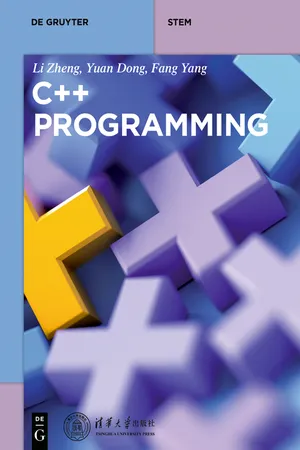Computer Science
C Array of Structures
A C array of structures is a data structure that allows you to store a collection of related data items of different data types. It is a way to group related data together and access them using a single name. Each element of the array is a structure that contains one or more data members.
Written by Perlego with AI-assistance
Related key terms
4 Key excerpts on "C Array of Structures"
- eBook - ePub
- D. Malhotra, N. Malhotra(Authors)
- 2019(Publication Date)
- Mercury Learning and Information(Publisher)
3ARRAYS
In This Chapter• Introduction• Definition of an array• Array declaration• Array initialization• Calculating the address of array elements• Analyzing an algorithm• Abstract data types• Declaration of two-dimensional arrays• Operations on 2-D arrays• Multidimensional arrays/ N-dimensional arrayys• Calculating the address of 3-D arrays• Arrays and pointers• Array of pointers• Arrays and their applications• Sparse matrices• Types of sparse matrices• Representation of sparse matrices• Summary• Exercises3.1Introduction
We have already studied the basics of programming in data structures and C++ in the previous chapter in which we aimed to design good programs, where a good program refers to a program which runs correctly and efficiently by occupying less space in the memory, and also takes less time to run and execute. Undoubtedly, a program is said to be efficient when it executes with less memory space and also in minimal time. In this chapter, we will learn about the concept of arrays. An array is a user-defined data type that stores related information together. Arrays are discussed in detail in the following sections.3.2Definition of an Array
An array is a collection of homogeneous (similar) types of data elements in contiguous memory . An array is a linear data structure because all elements of the array are stored in linear order. Let us take an example in which we have ten students in a class, and we have been asked to store the marks of all ten students; then we need a data structure known as an array.FIGURE 3.1 .Representation of an array of 10 elements.In the previous example, the data elements are stored in the successive memory locations and are identified by an index number (also known as the subscript), that is, Ai or A[i]. A subscript is an ordinal number which is used to identify an element of the array - eBook - ePub
Learn C Programming from Scratch
A step-by-step methodology with problem solving approach (English Edition)
- Mohammad Saleem Mir(Author)
- 2024(Publication Date)
- BPB Publications(Publisher)
HAPTER 5Arrays IntroductionIn this chapter, we will explore various topics related to arrays, string manipulation, and matrices in the context of programming. Arrays, which are one-dimensional structures, allow us to store and manipulate a collection of elements. We will learn how to perform operations on arrays, such as accessing elements and modifying their values. Additionally, we will delve into string manipulation, understanding how to work with strings effectively. Furthermore, we will delve into matrices and explore how to pass a two-dimensional matrix to a function.Structure In this chapter, we will cover the following topics:- Arrays (One-dimensional array)
- Array manipulation
- String manipulation
- Matrices
- Passing 2-D matrix to a function
The objective of this chapter is to provide a comprehensive understanding of arrays, string manipulation, and matrices. By the end of this chapter, you will be equipped with the knowledge and skills necessary to manipulate arrays effectively, perform string operations efficiently, and work with matrices in programming. Through practical examples and explanations, we aim to enable you to apply these concepts in your coding projects.Arrays: One-dimensional arrayIn the C programming language, arrays are a fundamental type of data structure. They offer a practical and effective approach to handling and storing identical data items. Understanding arrays is crucial for creating effective and reliable software, whether you are an expert programmer or a newbie learning C. We may store a fixed-size collection of identical-type objects using the C data structure called an array. Arrays can group related data objects associated with a single name. Arrays allow for the contiguous (one after the other) storage of a fixed-size sequential collection of objects of the same kind. However, it is sometimes more helpful to conceive an array as a group of variables of identical type. Since we assign a name to all the elements of an array, it is imperative to identify the individual elements of an array uniquely. To access individual elements of an array, we use a unique integer called index, - eBook - ePub
ANSI C Programming
Learn ANSI C step by step
- Yashavant Kanetkar(Author)
- 2020(Publication Date)
- BPB Publications(Publisher)
12 Structures- Why Use Structures Declaring a Structure Accessing Structure Elements How Structure Elements are Stored
- Array of Structures
- Additional Features of Structures
- Uses of Structures
- Summary
- Exercise
W hich mechanic is good enough who knows how to repair only one type of vehicle? None. Same thing is true about C language. It wouldn’t have been so popular had it been able to handle only all int s, or all float s or all char s at a time. In fact, when we handle real world data, we don’t usually deal with little atoms of information by themselves—things like integers, characters and such. Instead, we deal with entities that are collections of things, each thing having its own attributes, just as the entity we call a ‘book’ is a collection of things such as title, author, call number, publisher, number of pages, date of publication, etc. As you can see, all this data is dissimilar, for example, author is a string, whereas number of pages is an integer. For dealing with such collections, C provides a data type called ‘structure’. A structure gathers together, different atoms of information that comprise a given entity. And structure is the topic of this chapter.Why Use Structures
We have seen earlier how ordinary variables can hold one piece of information and how arrays can hold a number of pieces of information of the same data type. These two data types can handle a great variety of situations. But quite often we deal with entities that are collection of dissimilar data types.For example, suppose you want to store data about a book. You might want to store its name (a string), its price (a float) and number of pages in it (an int). If data about say 3 such books is to be stored, then we can follow two approaches:(a) Construct individual arrays, one for storing names, another for storing prices and still another for storing number of pages. (b) Use a structure variable. Let us examine these two approaches one by one. For the sake of programming convenience, assume that the names of books would be single character long. Let us begin with a program that uses arrays. - eBook - ePub
- Yuan Dong, Fang Yang, Li Zheng(Authors)
- 2019(Publication Date)
- De Gruyter(Publisher)
6Arrays, Pointers, and StringsAfter studying the concepts and applications of basic control structures, functions, and classes of C++, many problems can be described and solved. However, for large scales of data, especially when they are mutually correlated or are similar and correlated data, how to present and organize them efficiently remains a problem. The array type in C++ provides an effective way to organize objects of the same type.An important characteristic, which C++ inherits from C, is that we can directly use an address to access memory, and the pointer variable is an important data type for realizing this feature. Using pointers, we can conveniently process large amounts of data continuously stored in memory, achieve massive data sharing between functions at a comparatively low cost, and easily realize dynamic memory allocations.Using character arrays to make up the deficiency of string variables is an effective method inherited from C. However, from the object-oriented and security perspectives, strings represented by character arrays have deficiencies. Therefore, the standard class library of C++ provides the string class, which is a good example of expanding data types based on the class library.In this chapter, we will introduce the array type, pointer type, dynamic memory allocation, and how to store and process string data.6.1Arrays
To understand the function of an array, please consider this problem: how does one store and process a series of n integers in a program? If n is small, for example, n is 3, we can easily declare three variables of the int type. If n is 10,000, then we need to declare 10,000 variables of int type to represent these 10,000 numbers by int
Learn about this page
Index pages curate the most relevant extracts from our library of academic textbooks. They’ve been created using an in-house natural language model (NLM), each adding context and meaning to key research topics.



